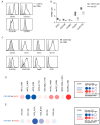Cord-Blood-Stem-Cell-Derived Conventional Dendritic Cells Specifically Originate from CD115-Expressing Precursors
- PMID: 30764500
- PMCID: PMC6406310
- DOI: 10.3390/cancers11020181
Cord-Blood-Stem-Cell-Derived Conventional Dendritic Cells Specifically Originate from CD115-Expressing Precursors
Abstract
Dendritic cells (DCs) are professional antigen-presenting cells which instruct both the innate and adaptive immune systems. Once mature, they have the capacity to activate and prime naïve T cells for recognition and eradication of pathogens and tumor cells. These characteristics make them excellent candidates for vaccination strategies. Most DC vaccines have been generated from ex vivo culture of monocytes (mo). The use of mo-DCs as vaccines to induce adaptive immunity against cancer has resulted in clinical responses but, overall, treatment success is limited. The application of primary DCs or DCs generated from CD34⁺ stem cells have been suggested to improve clinical efficacy. Cord blood (CB) is a particularly rich source of CD34⁺ stem cells for the generation of DCs, but the dynamics and plasticity of the specific DC lineage development are poorly understood. Using flow sorting of DC progenitors from CB cultures and subsequent RNA sequencing, we found that CB-derived DCs (CB-DCs) exclusively originate from CD115⁺-expressing progenitors. Gene set enrichment analysis displayed an enriched conventional DC profile within the CD115-derived DCs compared with CB mo-DCs. Functional assays demonstrated that these DCs matured and migrated upon good manufacturing practice (GMP)-grade stimulation and possessed a high capacity to activate tumor-antigen-specific T cells. In this study, we developed a culture protocol to generate conventional DCs from CB-derived stem cells in sufficient numbers for vaccination strategies. The discovery of a committed DC precursor in CB-derived stem cell cultures further enables utilization of conventional DC-based vaccines to provide powerful antitumor activity and long-term memory immunity.
Keywords: DC precursor; DC subsets; cancer; cord blood; dendritic cell; vaccine.
Conflict of interest statement
The authors declare no conflicts of interest and the funders had no role in the design of the study; in the collection, analyses, or interpretation of data; in the writing of the manuscript; or in the decision to publish the results.
Figures







Similar articles
-
CD14 Expressing Precursors Give Rise to Highly Functional Conventional Dendritic Cells for Use as Dendritic Cell Vaccine.Cancers (Basel). 2021 Jul 29;13(15):3818. doi: 10.3390/cancers13153818. Cancers (Basel). 2021. PMID: 34359719 Free PMC article.
-
Hematopoietic stem cell-derived myeloid and plasmacytoid DC-based vaccines are highly potent inducers of tumor-reactive T cell and NK cell responses ex vivo.Oncoimmunology. 2017 Feb 6;6(3):e1285991. doi: 10.1080/2162402X.2017.1285991. eCollection 2017. Oncoimmunology. 2017. PMID: 28405517 Free PMC article.
-
A simple two-step culture system for the large-scale generation of mature and functional dendritic cells from umbilical cord blood CD34+ cells.Transfusion. 2009 Oct;49(10):2109-21. doi: 10.1111/j.1537-2995.2009.02231.x. Epub 2009 May 27. Transfusion. 2009. PMID: 19497054
-
Cytokines in the generation and maturation of dendritic cells: recent advances.Eur Cytokine Netw. 2002 Apr-Jun;13(2):186-99. Eur Cytokine Netw. 2002. PMID: 12101074 Review.
-
Genetically modified dendritic cells in cancer therapy: implications for transfusion medicine.Transfus Med Rev. 2001 Oct;15(4):292-304. doi: 10.1053/tmrv.2001.26960. Transfus Med Rev. 2001. PMID: 11668436 Review.
Cited by
-
Functions of Dendritic Cells and Its Association with Intestinal Diseases.Cells. 2021 Mar 6;10(3):583. doi: 10.3390/cells10030583. Cells. 2021. PMID: 33800865 Free PMC article. Review.
-
Clinical Grade Production of Wilms' Tumor-1 Loaded Cord Blood-Derived Dendritic Cells to Prevent Relapse in Pediatric AML After Cord Blood Transplantation.Front Immunol. 2020 Sep 25;11:559152. doi: 10.3389/fimmu.2020.559152. eCollection 2020. Front Immunol. 2020. PMID: 33101274 Free PMC article.
-
Exopolysaccharide-Treated Dendritic Cells Effectively Ameliorate Acute Graft-versus-Host Disease.Transplant Cell Ther. 2024 Jan;30(1):79.e1-79.e10. doi: 10.1016/j.jtct.2023.10.023. Epub 2023 Nov 2. Transplant Cell Ther. 2024. PMID: 37924979 Free PMC article.
-
A method for the generation of large numbers of dendritic cells from CD34+ hematopoietic stem cells from cord blood.J Immunol Methods. 2020 Feb;477:112703. doi: 10.1016/j.jim.2019.112703. Epub 2019 Nov 9. J Immunol Methods. 2020. PMID: 31711888 Free PMC article.
-
Unlocking Dendritic Cell-Based Vaccine Efficacy through Genetic Modulation-How Soon Is Now?Genes (Basel). 2023 Nov 23;14(12):2118. doi: 10.3390/genes14122118. Genes (Basel). 2023. PMID: 38136940 Free PMC article. Review.
References
-
- Feuerstein B., Berger T.G., Maczek C., Roder C., Schreiner D., Hirsch U., Haendle I., Leisgang W., Glaser A., Kuss O., et al. A method for the production of cryopreserved aliquots of antigen-preloaded, mature dendritic cells ready for clinical use. J. Immunol. Methods. 2000;245:15–29. doi: 10.1016/S0022-1759(00)00269-6. - DOI - PubMed
-
- Thurner B., Roder C., Dieckmann D., Heuer M., Kruse M., Glaser A., Keikavoussi P., Kampgen E., Bender A., Schuler G. Generation of large numbers of fully mature and stable dendritic cells from leukapheresis products for clinical application. J. Immunol. Methods. 1999;223:1–15. doi: 10.1016/S0022-1759(98)00208-7. - DOI - PubMed
-
- Schadendorf D., Ugurel S., Schuler-Thurner B., Nestle F.O., Enk A., Brocker E.B., Grabbe S., Rittgen W., Edler L., Sucker A., et al. Dacarbazine (DTIC) versus vaccination with autologous peptide-pulsed dendritic cells (DC) in first-line treatment of patients with metastatic melanoma: A randomized phase III trial of the DC study group of the DeCOG. Ann. Oncol. 2006;17:563–570. doi: 10.1093/annonc/mdj138. - DOI - PubMed
-
- Prue R.L., Vari F., Radford K.J., Tong H., Hardy M.Y., D’Rozario R., Waterhouse N.J., Rossetti T., Coleman R., Tracey C., et al. A phase I clinical trial of CD1c (BDCA-1)+ dendritic cells pulsed with HLA-A*0201 peptides for immunotherapy of metastatic hormone refractory prostate cancer. J. Immunother. 2015;38:71–76. doi: 10.1097/CJI.0000000000000063. - DOI - PubMed
Grants and funding
LinkOut - more resources
Full Text Sources
Other Literature Sources

